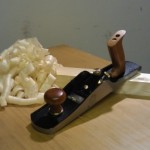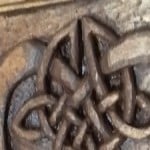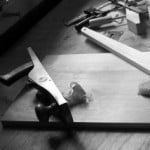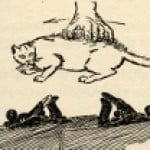Sharpening
Welcome! / Forums / General Woodworking Discussions / Sharpening
- This topic has 78 replies, 18 voices, and was last updated 11 years, 6 months ago by
 bloqbeta.
bloqbeta.
-
AuthorPosts
-
Anonymous9 November 2012 at 7:30 am #3077
How’s everyone getting along with their sharpening regime? 🙂
Have you any preferred tools or techniques?
9 November 2012 at 8:19 am #3078I have been using Paul’s method since I saw it a few weeks ago on You Tube and it works. I checked out the irons on my Grandfathers plough plane that hasn’t been used since the 60’s and notice that he sharpened in a similar way. I think that I have been brainwashed with all the new techniques micro bevels, honing guides, waterstones that i have ended up looking for the perfect shaving instead of achieving an edge to perform the job in hand which is mastering the plane.
I have also been caught in the ‘headlights’ of the high end tools which work very well, but have discovered that the Stanley “plain Jane” number 4 with a thin iron works equally as well.
I have recently started buying old saws and now need to learn to sharpen / tune them.

My sharpening setup consists of a set of Naniwa superstones (800, 2000 and 8000 grit) plus a DMT Dia-flat lapping plate to flatten them.
I am quite happy with this setup, despite the mess with water all around… the next thing I’m going to add is a coarser grit waterstone or diamondstone for the heavy duty work when lapping the backs of new (to me, used or new) tools.I currently have two honing guides, a veritas mkII and an eclipse side clamping clone.
I first got the Veritas mkII but soon realized that it has some downsides. Don’t get me wrong it’s a very solid piece of equipment but a few things could be improved.
The top-bottom clamping solution gives be difficulty holding chisels and plane irons rock solid. Even though I tighten the fastening screws as much as I dare things shift on me and the iron is out of square.
I have also hade issues with the metal stop on the registration guide. The problem being that it is made out of metal… even if I am careful when inserting and clamping I have damaged the edge of the iron on the metal stop. Annoying to say the least.
Recently I realized that the wheel on my guide is less than perfect – the micro bevel adjustment seems to put the wheel in a skew. In normal mode the wheel is straight but when set to create the micro bevel the wheel is of by 0.2mm on one side. This results in a skewed micro bevel… not what I wanted.So I got the cheap eclipse guide and so far it is a better help. It needs a little fine tuning but will not suffer from the above issues.
All this fiddling with the honing guides have really created a sincere desire to acquire the skill of freehand sharpening.
Hopefully Paul will go thru this in the masterclass series and I can put my honing guides to rest in a box 🙂A question for the masses: what method do you use to determine when you have achived the perfect edge? I currently try to shave some hair of my arm, and if that works I deem it sharp enough. I have seen tests using end grain cuts on softwoods and some use paper slicing as an evaluation form.
Anonymous9 November 2012 at 8:31 am #3081Hi Steve,
It’s good knowing you’re settling into good technique, as well as realising the fact it doesn’t/shouldn’t cost too much to gain a very decent head start in woodworking my friend. 🙂
Follow Paul’s excellent teaching and advice and you’ll never go wrong 😉
Anonymous9 November 2012 at 8:41 am #3082I tend to go through my grits and finish on a black/translucent arkansas stone before stropping. Knowing how sharp an edge is tends to come with practise, but it’s good to go, as long as there’s no light reflected from the intended edge and it’s capable of grabbing the skin on the tip of my thumb when I check across the edge.
Always ensure you’ve removed the burr froma freshly whetted edge.
Working with and trusting the manner with which the finer grits enhance an edge is a major part to successful sharpening.
I sharpen freehand and primarily with DMT and EzeLap diamond plates using coarse, medium, fine and extra fine grades.
 10 November 2012 at 2:54 am #3089
10 November 2012 at 2:54 am #3089I use oil stones and strop with the green stuff. I am very pleased with my results. I have tried all the systems. They all work. Paul’s method intrigues me. May experiment with it.
Anonymous10 November 2012 at 7:54 am #3090Hi Ron,
Paul’s method most definitely works and in fact works extremely well 🙂
 10 November 2012 at 9:07 pm #3113
10 November 2012 at 9:07 pm #3113Gary, i am not sure I am ready to get rid of my very good oil stones?
 10 November 2012 at 9:35 pm #3114
10 November 2012 at 9:35 pm #3114I use the same system that jesper uses except i use norton and king stones. As far as testing i still shave to Does anyone use shapton stone i like the no presoak but they are expensive and they are pretty thin looking
Anonymous10 November 2012 at 10:03 pm #3115Hi Ron,
I still have and use my oil stones and definitely wouldn’t knock anyone’s sharpening preferences, but came to prefer diamond plates for the sake of less time spent sharpening.

Fortunately I was taught how to sharpen knives and tools by a family friend when I was a teenager. After seeing Pauls method in the DVDs I realized it was the same except I was shown the use of only two stones instead of three and we never had paste for the strop. When diamond stones came on the market I switched to them as my oilstones wore out. I use water stones for my razor.
11 November 2012 at 3:17 am #3117Jesper – Paul’s “Working Wood 1&2” book and associated DVDs include a comprehensive description of his sharpening methods as well as detailed instructions on many basic techniques that lead towards the consistent accuracy Paul demands in his own work. I learn something new each time I re-read his instructions. Very often it’s his subtle comments that lead me to greater understanding. This holds true in all of his presentations, at least for me.

“And. Here. We. Go!” –The Joker (Heath Ledger)
My current preference is for waterstones, only two grits 800 and 8000 for flat plane blades and chisels. I favor the “ruler trick” to make a small back bevel so I don’t have to fool about with flattening backs of vintage plane blades, or even new ones for that mater. For my chisels, I’ve got some with flat backs and a few with “ruler trick” backs. So far, no major difference in function of operating qualities. YMMV. I tend to use my water stones free-hand.
For curved blades and carving chisels and whatnot I have been using oilstones in flat and shaped configurations. All work just fine for me.
For damaged blades that do require grinding I previously used a standard 6″ grinder but have since switched to a hand-crank grinder. Not so much because of the “slow speed can’t blue steel” myth — it isn’t a myth, it will blue it lickey-split,, but because the hand-crank is so much smaller and easier to store. Frankly, I have no problem grinding on a standard fast grinder. It is all about a good, well dressed, coarse stone, light touch and PAYING ATTENTION! For special cases, I’ll make a “fid” of the right shape and use sandpaper to do the rough “grinding” work.
All that said, about 3 months ago I did purchase a coarse, medium and fine diamond stone to investigate the convex bevel “method” and to evaluate the diamond plates as a suitable method to place into the shop at my local woodworking guild (more below). It works. That’s the short answer. I plan to continue experimenting with the method for at least another 3 months before I decide if I want to make the switch to full time diamond stones. Also I already used a strop so that step is really no different for me.
Disclaimer & disclosure : I am the current President of the Kansas City Woodworkers’ Guild. Our current membership is hovering around 500 and we offer to our members a fully equipped shop. I take some teasing for working mostly with handtools but that is primarily because I don’t care for the noise and mess at home of all the power equipment. So this also means it falls to me and a few others to help set up our shop space for handtool work. Thus, evaluating a couple brands of continuous diamond plates. Given the propensity of our members to NOT SHARPEN tools (lazy, but I digress) but rather just stuff them back in the rack I want sharpening equipment available to them that requires minimum maintenance. So waterstones are right out. Diamond plates or oil stones are pretty much the only possible solution for an semi-public shop hand sharpening solution. I’m leaning toward the diamond stones as the least troublesome. And I’m not going to recommend that the KCWG provide jigs as the long term problems outweigh the short term hassle of learning to work free hand.Anonymous11 November 2012 at 10:17 am #3121Hi Rob,
Ease of maintenance and durability fall very firmly in the lap of diamond plates. Two brands I use and am very familiar with are DMT duo sharp and Eze Lap diamond plates and I’ve no issues in terms of flatness and their ability to handle very regular use. I’m awaiting delivery of some very fine natural finishing stones and should be able to report on their suitability shortly, but am told their qualities are very close to those of translucent/black Arkansas stones.
For blade maintenance I used to use a hand cranked grinding wheel years ago during my apprenticeship (It’s still boxed away since my recent house move) and even found myself rigging it up for use with my power drill. I hasten to add the fact I soon progressed onto using a powered grinding wheel 🙂

I’ve watched Pauls videos on Youtube where he demonstrates how to sharpen chisels and plane irons.
Compared to other methods described on the net and in books Paul’s system is a bit different.1. Only one bevel. Other methods prescribe one, two or even three (!) so called micro-bevels in addition to the normal bevel.
2. Uses coarser grits than most other methods I’ve seen. Paul’s grit series is 250 -> 600 -> 1 200 -> 15 000 (leather strop) if I understand correctly.
3. Doesn’t spend a lot of time working on the back side in the normal sharpening round. I guess that a proper lapping of the back is part of his routine when acquiring a new tool.
4. Fast. I guess that Paul spends less than a minute including setup time to sharpen the tool at hand.
A question that pop up in my head when reviewing the items above:
Is the use of coarser grits connected to the fact that we maintain the entire bevel surface at all sharpening sessions. The use of micro-bevels might put off the use of coarse work in the small maintenance rounds but will require a re-grind of the normal angle bevel regularly.In order to match the speed Paul keeps I guess the only way is to leave the honing guides behind. Just placing the tool in the guide and adjusting it has wasted at least half of the time Paul needs to complete a tool.
-
AuthorPosts
- You must be logged in to reply to this topic.
